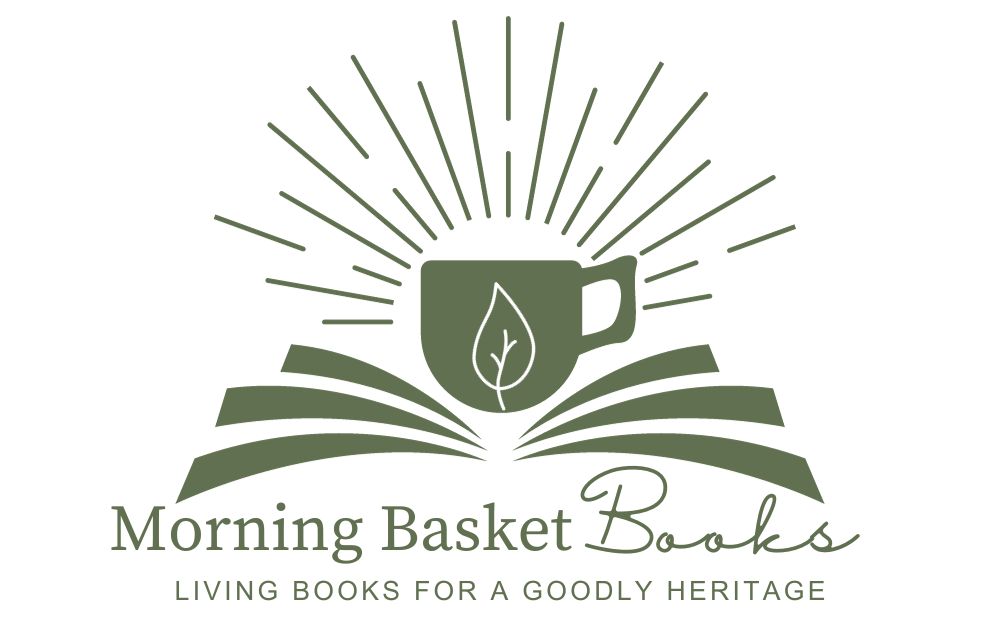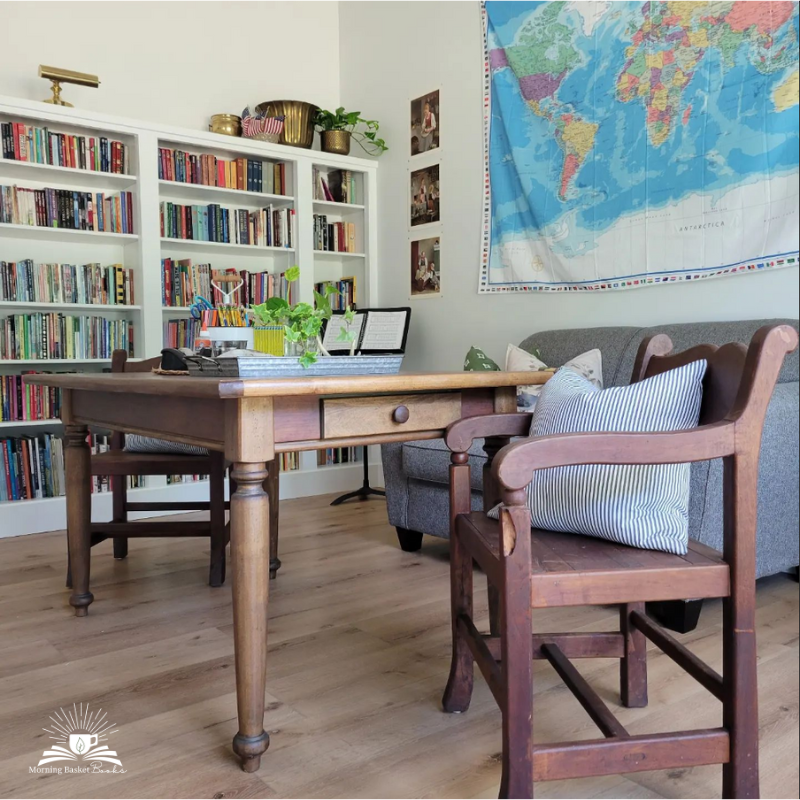What is a ‘living book’? Defining the term is not as simple as it may seem. Although most living books share the same characteristics, what makes a living book come alive for one child, may not necessarily do so for another.
Charlotte Mason emphasized that a book must be enjoyed to be effective.
Living Books Must Be Enjoyed
Charlotte Mason
“So much for the right books; the right use of them is another matter. The children must enjoy the book. The ideas it holds must each make that sudden, delightful impact upon their minds, must cause that intellectual stir, which mark the inception of an idea.”
Those books that “make that sudden, delightful impact upon {their} minds,” and “cause that intellectual stir, which mark(s) the inception of an idea,” may differ from child to child, based upon their natural, God-given bent.
One reason textbooks are rarely memorable or enjoyable is because they are often crammed with facts of pre-determined importance by a committee appointed to decide what children should know at a certain age. Alternatively, living books are usually written by a single author who has personal experience or a particular enthusiasm for the subject, doing much more to ignite a child’s imagination and curiosity about a particular subject.
Textbooks may be an efficient way to produce good test results (it takes far less time to remember mere names and dates than it does to convey an idea), but what good does that information do if it is soon forgotten? Stories are remembered with fondness for years to come, and they challenge a child to act upon what he has learned.
Compare this to what Charlotte believed children should remember of the books they read:
Charlotte Mason
“The children’s lessons should provide material for their mental growth, should exercise the several powers of their minds, should furnish them with fruitful ideas, and should afford them knowledge, really valuable for its own sake, accurate, and interesting, of the kind that the child may recall as a man with profit and pleasure.”
Living Books Are Usually Written by a Single Author
Living books are written by people whose knowledge or delight in the topic, either through first-hand experience, or personal interest, is shared with contagious passion.
Authors of living books make their subject “come alive,” often by using narrative or conversational tone, and by engaging a reader’s emotions. Books that move us are hard to forget; what we are able to tell others about a book in our own words is the test of how well the knowledge has been assimilated.
Since a living book is written by someone with authority on the subject – someone who was a thinker before they were a writer – they are not usually written at “grade level,” and appeal to a wide range of ages.
Living Books Are Multi-Generational
Living Books are just as enjoyable for parents to read to their children, as children find reading the book to themselves. In other words, they are Classics. Living books appeal to old and young alike. When your children plead, “just one more chapter!” you may find yourself complying, just as much for your sake as theirs!
Living Books make the best bed time stories, because the entire family can gather around and enjoy a chapter or two of imagination stirring narrative that will certainly produce fodder for good dreams and ideas for the next day’s play!
Charlotte Mason
“To introduce children to literature is to install them in a very rich and glorious kingdom, to bring a continual holiday to their doors, to lay before them a feast exquisitely served. But they must learn to know literature by being familiar with it from the very first. A child’s intercourse must always be with good books, the best that we can find.”
It may be necessary to do a lot of reading aloud yourself during the younger years until your children are old enough to read for themselves. This can be time consuming, of course, but the trade-off is that you can teach multiple ages at once, since living books will hold the attention of multiple ages.
Living Books Convey Ideas Rather Than Just Fact
Before I started began to think of living books as potential textbook replacements, I gravitated towards those beautiful, color-printed DK Eye Witness Smithsonian publications. I still pick them up when I’m able, and enjoy leaving them around the house for the kids to pick up and discover through their own volition.
These books impart factual information in an eye-catching way. They often have stunning graphics, photos, or diagrams that take up much of the page, with little snippets of interesting information highlighted by boxes in the margins.
However, these books could not be considered works of literary genius. If you were to take out all the pictures and fun doodles, and string the text into one paragraph, it would read like a choppy, soulless encyclopedia entry. It’s all just fact.
Living books don’t require pictures to make sense of the text; pictures should enhance the text that is already there. The verse itself should the draw the reader in and capture their interest and imagination with passionate, original narrative.
Living Books Must Be Replenished Often
Charlotte Mason
“One more thing is of vital importance; children must have books, living books. The best is not too good for them; anything less than the best is not good enough. And if it is needful to exercise economy, let go everything that belongs to soft and luxurious living before letting go the duty of supplying the books, and the frequent changes of books, which are necessary for the constant stimulation of the child’s intellectual life.”
Previously, when I ordered Science, Geography, and History materials for the year, I would receive a student textbook, a student workbook, a teacher’s manual, and a testing booklet in one convenient package. I would be set for the whole year, and when the kids finished, they would be done the grade number it stated in the top corner of the book.
Living books are a different animal. They are whole books. Instead of being a collection of facts on a variety of things from multiple sources, they usually deal with a singular idea or subject at a time. It’s up to the child to pull out those facts he finds to be of great importance.
Textbooks go a mile wide, and an inch deep, making it difficult to remember the information for very long; living books go a mile deep and an inch wide. They are easier to assimilate, and therefore, have greater long-term influence.
Some would see this as a drawback, because in order to “spread an abundant and delicate feast in the programmes (where) each small guest assimilates what he can,” we need to be stocking our homes with good literature and plenty of it! Much borrowing or purchasing, and many trips to the library are needed to make a living education successful!
Living Books Change People
Charlotte Mason
“We have never been so rich in books. But there has never been a generation when there is so much twaddle in print for children.”
Twaddle.
I love that word! Charlotte Mason coined the term to describe books of useless nonsense that children often enjoy reading but are not benefited from.
Books such as “The Babysitter’s Club,” “Diary of a Wimpy Kid,” and “Captain Underpants,” would fall into this category. They often come in a series with predictable plot lines and flat characters. They lack rich descriptions and passion for a particular subject, using “dumbed down” vocabulary. They are “junk food” in the literary world. A steady diet of twaddle is not healthy, and ruins our taste for the good stuff!
Some Charlotte Mason homeschoolers may not agree with me on this, but I have made use of “twaddle” (i.e. The Boxcar Children series) to help beginning or struggling readers to discover they can read a whole book on their own.
Unlike twaddle, Living Books change the person who reads them. The triggering of the imagination results in theories, inventions, discoveries, and creations. In the most pleasant way possible, a living book challenges a child’s ability to think critically, ponder, and suppose.
Living books can be old or new, fiction or non-fiction, but one thing is for certain, a person is better for reading it.
The One Page Test
Karen Andreola, in her beautiful book, The Charlotte Mason Companion, tells about her “One Page Test” for determining whether or not a book is “living.” It is this:
Karen Andreola
Read one page of a book out loud to your children. If they are drawn into the story, and cry “Another page!” when you’ve reached the end, you may be fairly confident that you have discovered a living book.

